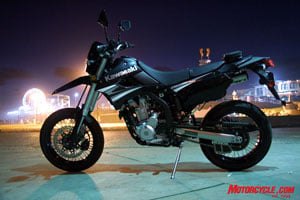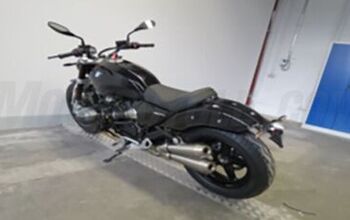2009 Kawasaki KLX250SF Review - Motorcycle.com
Back in September of 2008, Kawasaki added a brand new model to their on/off-road sector, answering the call for an economical yet exciting bike for the shallow-pocketed hooligans out there. Building upon the successful and able KLX250S that won our Lightweight Dual-Purpose Shootout, Kawasaki has spiced it up and slapped the letter “F” to the title. Say hello to the KLX250SF.
With a street-tuned suspension and re-engineered drive train, the SF is designed with “an air of purposeful aggression” and includes a blackened frame and sleek black/grey bodywork. The new setup is perfect for me because I was already flogging the S-model around the City of Angels when I couldn’t get myself out to the trails. As an urban commuter mount, requiring barely more space to park than a downhill mountain bike, the SF is rip-roaring fun.
For the most part, the new SF model is a city-slickened and supermoto-styled KLX250S with the same four-stroke liquid-cooled 249cc DOHC four-valve Single. On the Area P dyno, the SF was able to crank out 2.5 horsepower more, up to 20.5 ponies at 8,800 rpm - possibly due to a better transmission of power from the street tires than the S’s knobbies. Torque is up marginally to 13.7 ft-lbs at 7,400 rpm. The SF model employs a taller 39-tooth rear sprocket and street rubber to deliver more confident higher-speed street riding. Redlining at 10,500 rpm with a sweet spot between the 7,000 to 9,000 rpm rev range, the SF sure is a screamer.
With a fully fuelled wet weight of 302 lbs, the 50-state legal SF is still carbureted but starts with a breeze thanks to the Kawasaki Automatic Compression Release (KACR) also found on the S-model. KACR automatically lifts one of the exhaust valves at cranking rpm for reduced starting effort. A hard-to-reach manual choke knob is there to assist with cold starts.
Combining a more snug suspension setup with a set of smaller 17-inch wheels, the SF is part roller coaster and part merry-go-round. Compared again to the S-model, the SF reduces its front wheel travel on the 43mm inverted cartridge fork (with 16-click adjustable compression damping) from 10-inches to 9.1-inches. Out back, the fully preload adjustable compression and rebound gas-charged shock is also lessened from 9.1 to 8.1 inches.
Combining the lesser wheel travel with the same 56.3-inch wheelbase, the SF is more stable and has a lower center of gravity, yet it soaks up road bumps with ease. While the ride is comfortable, it’s the narrow saddle that’ll bite you the hardest. Thusly the ground clearance has also been reduced as a matter of geometry to 8.9-inches from 11.2-inches. Kawasaki engineers also changed the front fork oil level and revised the damping settings for both the fork and shock to help tune the SF to every rider as well as the motard wannabes.
Hung from each end of that setup are a pair of spoked 17-inch aluminum wheels with larger brake rotors than the S-model at both the front and rear. The sexy motard-style front wheel is wrapped with a 110/70 section tire, and the rear differs from the S-model by only one inch, sporting a 130/70-17 IRC Road Winner tire. Taking the brunt of the braking power at the helm is a 300mm semi-floating petal disc with two-piston hydraulic caliper - up from the 250mm disc found on the S’s 21-inch wheel. The single-piston rear differs by only 20mm (up from 220 to 240mm) to help keep the higher-speed KLX250SF in check.
Given the lesser wheel travel, and smaller wheels, the KLX-SF can better accommodate beginning and shorter-inseamed riders with it’s 1.1-inch lower saddle height (33.9 inches), putting it near the bottom of the scale against its competitors – the opposite of the on/off-road versions of the 250cc bikes in this market.
The cheaper Honda CRF230M has a seat height of just 31.7-inches and a $4,749 MSRP. The Yamaha WR250X that Kevin Duke tested for us in December 2008 has a taller saddle height of 35.2-inches and an even taller MSRP of $6,190. Indirect competition from Suzuki is the larger capacity DR-Z400SM and similarly scalar MSRP and saddle height of $6,299 and 35-inches, respectively.
The 2009 Kawasaki KLX250SF lands in the middle of the road with a MSRP of just $5,299. That’s $400 more than the S-model, but there’s more than just price tucked into this lightweight machine. If you’re looking for a supermoto-styled standard as your next commuter mount, the KLX250SF has the creature comforts any new rider will appreciate, like rubber footpegs, uniquely shaped mirrors, a robust digital dashboard with two tripmeters and sweeping tachometer, onboard toolkit and helmet lock as seen on the KLX-S model. All this, plus a lower saddle and center of gravity for enhanced straight-line performance and on-road handling.
Feather-light steering and exemplary fuel economy also tread’s lightly on your wallet with an advertised 70-mpg. Our initial testing showed just 45 mpg, but we barely let the little piston dip below the horsepower peak of 8,500 rpm (an indicated 80 mph) with a 200 lb rider aboard. With the SF’s 2.0-gallon tank, expect fuel stops to arrive not much further than 100 miles.
We’ve been impressed with the KLX250SF so far, but its big test comes it takes on Yamaha’s quarter-liter supermoto burner, the WR250X, in an upcoming shootout. Stay tuned.
Related Reading
2009 Kawasaki KLX250S Review
2008 Lightweight Dual-Purpose Shootout
2009 Yamaha WR250X Review
More by Alfonse Palaima
































Comments
Join the conversation